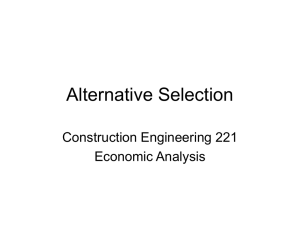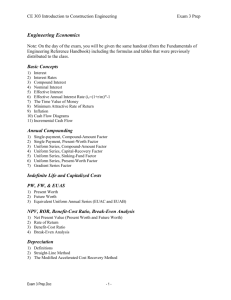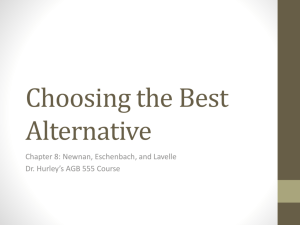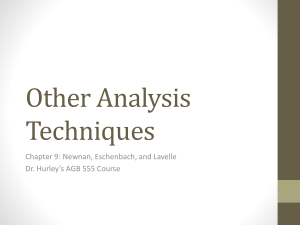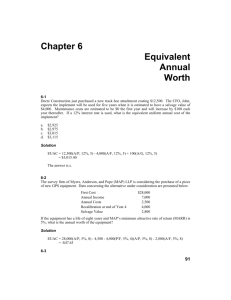Comparison of Alternatives
advertisement
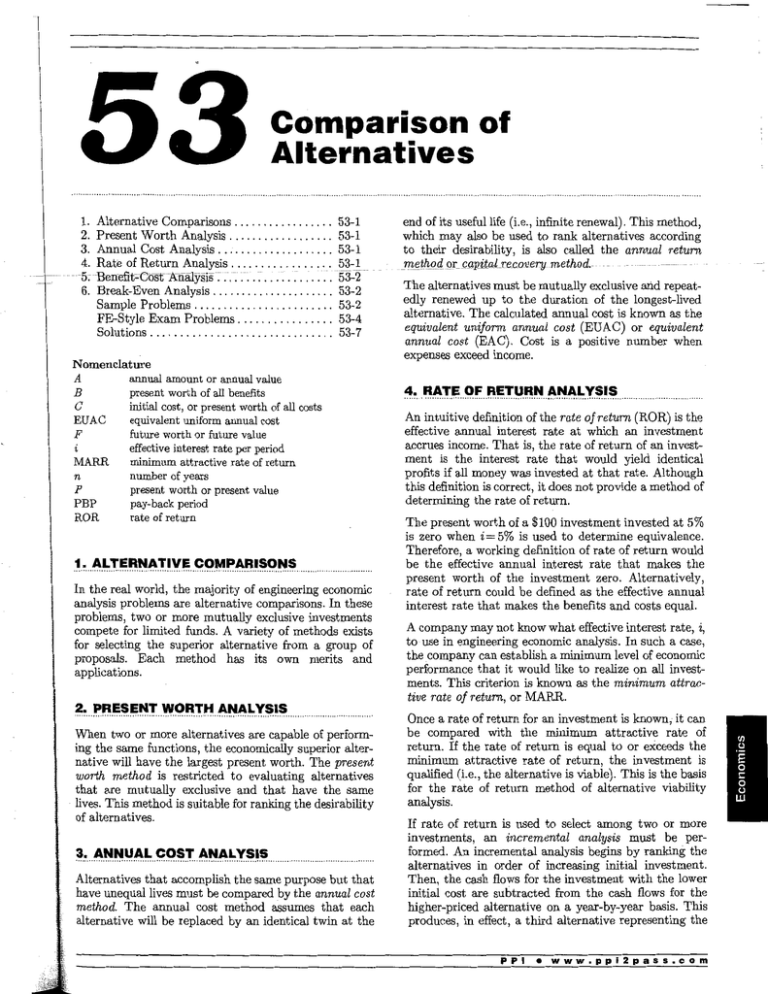
Comparison of
Alternatives
1. Alternative Comparisons . . . . . . . . . . . . . . . . .
2. Present Worth Analysis ..................
3. Annual Cost Analysis ....................
4. Rate of Return Analysis . . . . . . . . . . . . . . . . .
---5: -Berrefit::eost-A:nalysis:: ..... : ............
6. Break-Even Analysis .....................
Sample Problems . . . . . . . . . . . . . . . . . . . . . . . .
FE-Style Exam Problems . . . . . . . . . . . . . . . .
Solutions . . . . . . . . . . . . . . . . . . . . . . . . . . . . . . .
53-1
53-1
53-1
53-1
53-253-2
53-2
53-4
53-7
Nomenclature
A
annual amount or annual value
B
present worth of all benefits
C
initial cost, or present worth of all costs
EUAC
equivalent uniform annual cost
F
future worth or future value
i
effective interest rate per period
MARR
minimum attractive rate of return
n
number of years
p
present worth or present value
PBP
pay-back period
rate of return
ROR
1. ALTERNATIVE COMPARISONS
································································································································
In the real world, the majority of engineering economic
analysis problems are alternative comparisons. In these
problems, two or more mutually exclusive investments
compete for limited funds. A variety of methods exists
for selecting the superior alternative from a group of
proposals. Each method has its own merits and
applications.
~~---~~.I::~II:.~!. . W.Q.I.I.I.~ . ~~~-~!.~~~-·-·· .························ ...
When two or more alternatives are capable of performing the same functions, the economically superior alternative will have the largest present worth. The present
worth method is restricted to evaluating alternatives
that are mutually exclusive and that have the same
lives. This method is suitable for ranking the desirability
of alternatives.
~~---~-~~~-~~--~9..~!.. ~~~~!.~~~············ ································
Alternatives that accomplish the same purpose but that
have unequal lives must be compared by the annual cost
method. The annual cost method assumes that each
alternative will be replaced by an identical twin at the
end of its useful life (i.e., infinite renewal). This method,
which may also be used to rank alternatives according
to their desirability, is also called the annual return
_m,ejh_o_d, gr_ Ga'[lit.al_recov.ery method.
The alternatives must be mutually exclusive and repeatedly renewed up to the duration of the longest-lived
alternative. The calculated annual cost is known as the
equivalent uniform annual cost (EUAC) or equivalent
annual cost (EAC). Cost is a positive number when
expenses exceed income.
4.
RATE OF RETURN ANALYSIS
·······································································································
An intuitive definition ofthe rate of return (ROR) is the
effective annual interest rate at which an investment
accrues income. That is, the rate of return of an investment is the interest rate that would yield identical
profits if all money was invested at that rate. Although
this definition is correct, it does not provide a method of
determining the rate of return.
The present worth of a $100 investment invested at 5%
is zero when i = 5% is used to determine equivalence.
Therefore, a working definition of rate of return would
be the effective annual interest rate that makes the
present worth of the investment zero. Alternatively,
rate of return could be defined as the effective annual
interest rate that makes the benefits and costs equal.
A company may not know what effective interest rate, i,
to use in engineering economic analysis. In such a case,
the company can establish a minimum level of economic
performance that it would like to realize on all investments. This criterion is known as the minimum attractive rate of return, or MARR.
Once a rate of return for an investment is known, it can
be compared with the minimum attractive rate of
return. If the rate of return is equal to or exceeds the
minimum attractive rate of return, the investment is
qualified (i.e., the alternative is viable). This is the basis
for the rate of return method of alternative viability
analysis.
If rate of return is used to select among two or more
investments, an incremental analysis must be performed. An incremental analysis begins by ranking the
alternatives in order of increasing initial investment.
Then, the cash flows for the investment with the lower
initial cost are subtracted from the cash flows for the
higher-priced alternative on a year-by-year basis. This
produces, in effect, a third alternative representing the
PPI
•
www.ppi2pass.com
53-2
F E
R E V I E W
M A N U A L
costs and benefits of the added investment. The added
expense of the higher-priced investment is not warranted unless the rate of return of this third alternative
exceeds the minimum attractive rate of return as well.
The alternative with the higher initial investment is
superior if the incremental rate of return exceeds the
minimum attractive rate of return.
Finding the rate of return can be a long, iterative process, requiring either interpolation or trial and error.
Sometimes, the actual numerical value of rate of return
is not needed; it is sufficient to know whether or not the
rate of return exceeds the minimum attractive rate of
___ return._Thi_~_ com:RarJJ,tiv~ analysis can be accomplished
---Without calculating the rate Ofreturns1mp1y by finaing-the present worth of the investment using the minimum
attractive rate of return as the effective interest rate
(i.e., i= MARR). If the present worth is zero or positive,
the investment is qualified. If the present worth is negative, the rate of return is less than the minimum attractive rate of return and the additional investment is not
warranted.
The present worth, annual cost, and rate of return
methods of comparing alternatives yield equivalent
results, but they are distinctly different approaches.
The present worth and annual cost methods may use
either effective interest rates or the minimum attractive
rate of return to rank alternatives or compare them to
the MARR. If the incremental rate of return of pairs of
alternatives are compared with the MARR, the analysis
is considered a rate of return analysis.
5. BENEFIT·COST ANALYSIS
accomplished by calculating the ratio of differences in
benefits to differences in costs for each possible pair of
alternatives. If the ratio exceeds 1.0, alternative 2 is
superior to alternative 1. Otherwise, alternative 1 is
superior.
53.1
6. BREAK·EVEN ANALYSIS
Break-even analysis is a method of determining when
the value of one alternative becomes equal to the value
a!l.other~lrlscommorily-usea-to ae1rerrrlinewlren:CC)SfEi------+exactly equal revenue. If the manufactured quantity is
less than the break-even quantity, a loss is incurred. If
the manufactured quantity is greater than the breakeven quantity, a profit is made.
of
An alternative form of the break-even problem is to find
the number of units per period for which two alternatives have the same total costs. Fixed costs are spread
over a period longer than one year using the EUAC
concept. One of the alternatives will have a lower cost
if production is less than the break-even point. The
other will have a lower cost if production is greater than
the break-even point.
The pay-back period, PBP, is defined as the length of
time, n, usually in years, for the cumulative net annual
profit to equal the initial investment. It is tempting to
introduce equivalence into pay-back period calculations,
but the convention is not to.
C- (PBP)(net annual profit) = 0
The benefit-cost ratio method is often used in municipal
project evaluations where benefits and costs accrue to
different segments of the community. With this method,
the present worth of all benefits (irrespective of the
beneficiaries) is divided by the present worth of all costs.
(Equivalent uniform annual costs can be used in place of
present worths.) The project is considered acceptable if
the ratio equals or exceeds 1.0 (i.e., B/ C 2: 1.0). This
will be true whenever B- C 2: 0.
When the benefit-cost ratio method is used, disbursements by the initiators or sponsors are costs. Disbursements by the users of the project are known as
disbenefits. It is often difficult to determine whether a
cash flow is a cost or a disbenefit (whether to place it in
the denominator or numerator of the benefit-cost ratio
calculation).
Regardless of where the cash flow is placed, an acceptable project will always have a benefit-cost ratio greater
than or equal to 1.0, although the actual numerical
result will depend on the placement. For this reason,
the benefit-cost ratio alone should not be used to rank
competing projects.
If ranking is to be done by the benefit-cost ratio method,
an incremental analysis is required, as it is for the rateof-return method. The incremental analysis is
PPI
•
www.ppi2pass.com
Ar.
Pr
sit
m:
gi·
ra
U:
53.2
SAMPLE PROBLEMS
Problem 1
p
A company purchases a piece of construction equipment
for rental purposes. The expected income is $3100
annually for its useful life of 15 years. Expenses are
estimated to be $355 annually. If the purchase price is
$25,000 and there is no salvage value, what is the prospective rate of return, neglecting taxes?
v
C<
(A) 5.2%
(B) 6.4%
(C) 6.8%
(D) 7.0%
Solution
The rate of return can be viewed as the effective annual
interest rate that makes the present worth of the investment equal to zero.
'
....
1
C 0 M P A R I S 0 N
0 F
A L T E R N A T I V E S
53-3
Problem 3
p = 0 = -$25,000
+ ($3100) (PI A, i%, 15)
- ($355)(PI A, i%, 15)
$25,000 = ($2745)(PI A, i%, 15)
9.1075 = (PI A, i%, 15)
What is the approximate equivalent uniform annual
cost of machine Y?
(A) $1160
(B) $1300
(C) $1490
Use linear interpolation as an approximation.
(D) $1510
(PI A, 6%, 15) = 9.7122
Solution
(PI A, 8%, 15) = 8.5595
The equivalent uniform annual cost is
----
----
--- -(BUA:e}y-=
c$t2~00tJ)t-AtP;-8%-;-t3t::r- $175-
-------
- ($4000)(AI F, 8%, 13)
i% = 6% + (0.5245)(8%- 6%)
= ($12,000)(0.1265)
= 7.049% (7.0%)
+ $175
- ($4000)(0.0465)
= $1507 ($1510)
Answer is D.
Problem 2 through Prob. 4 refer to the following
situation.
An industrial firm uses an economic analysis to determine which of two different machines to purchase. Each
machine is capable of performing the same task in a
given amount of time. Assume the minimum attractive
rate of return is 8%.
Answer is D.
Problem 4
Which, if either, of the two machines should the firm
choose, and why?
(A) machine X because (EUAC)x < (EUAC)y
(B) machine X because (EUAC)x > (EUAC)y
Use the following data in this analysis.
(C) machine Y"because (EUAC)x < (EUAC)y
initial cost
estimated life
salvage value
annual maintenance cost
machine X
$6000
7 years
none
machine Y
$12,000
13 years
$4000
$150
$175
(D) machine Y because (EUAC)x > (EUAC)y
Solution
(EUAC)x < (EUAC)y
Machine X represents the superior alternative, based on
a comparison of EUACs.
Problem 2
What is the approximate equivalent uniform annual
cost of machine X?
Answer is A.
Problem 5
(A) $1000
Going Broke County is using a 10% annual interest rate
to decide if it should buy snowplow A or snowplow B.
(B) $1120
(C) $1190
(D) $1300
Solution
The approximate equivalent uniform annual cost is
(EUAC)x = ($6000)(AI P, 8%, 7)
+ $150
= ($6000)(0.1921) + $150
= $1302.60 ($1300)
Answer is D.
initial cost
life
annual operations and
maintenance
annual benefits
salvage value
snowplow A
$300,000
10 years
$45,000
snowplow B
$400,000
10 years
$35,000
$150,000
$0
$200,000
$10,000
What are the benefit-cost ratios for snowplows A and B,
respectively, and which snowplow should Going Broke
County buy?
PPI
•
www.ppi2pass.com
53-4
F E
R E V I E W
-
M A N U A L
(A) 2.2, 1.8; snowplow A
Problem 6
(B) 2.6, 2.1; snowplow A
A company produces a gear that is commonly used by
severallawnmower manufacturing companies. The base
cost of operation (rent, utilities, etc.) is $750,000 per
year. The cost of manufacturing is $1.35 per gear. If
these gears are sold at $7.35 each, how many must be
sold each year to break even?
(C) 1.4, 1.8; snowplow B
(D) 1.6, 2.0; snowplow B
Solution
The benefit-cost method requires the cash flows to be
converted to present worths.
(A) 65,000 per year
(B) 90,000 per year
(C) 100,000 per year
For snowplow A,
(D) 125,000 per year
~C=$30D;000+--:(~45~0QO)t:P/:1l.;lO%, lG]
= $300,000 + ($45,000)(6.1446)
Solution
= $576,507
The break-even point for this problem is the point at
which costs equal revenues.
B = ($150,000)(P I A, 10%, 10)
= ($150,000)(6.1446)
costs= $750,000 + ($1.35)(no. of gears)
revenues= ($7.35)(no. of gears)
= $921,690
$750,000 + ($1.35)(no. of gears)= ($7.35)(no. of gears)
B
$921,690
c $576,507
= 1.6
$750,000
no. of gears= $ _ _ $1.
7 35
35
= 125,000
For snowplow B,
Answer is D.
c = $400,000 + ($35,000)(PI A, 10%, 10)
- ($1ci,OOO)(PI F, 10%, 10)
= $400,000 + ($35,000)(6.1446) - ($10,000)(0.3855)
= $611,206
B = ($200,000) (PI A, 10%, 10)
= ($200,000)(6.1446)
= $1,228,920
B
FE-STYLE EXAM PROBLEMS
1. Calculate the rate of return for an investment with
the following characteristics.
initial cost
project life
salvage value
annual receipts
annual disbursements
$20,000
10 years
$5000
$7500
$3000
$1,228,920
$611,206
c
(A) 19.6%
= (2.0)
(B) 20.6%
To rank the projects using the benefit-cost ratio
method, use an incremental analysis. From Eq. 53.1,
(C) 22.9%
(D) 24.5%
~2 - ~1 ~ 1
2-
[for choosing alternative 2]
1
B2- B1
c2- c1
=
$1,228,920- $921,690
$611,206- $576,507
8.85 > 1
The additional investment is warranted. Alternative 2 is
superior; choose snowplow B.
Answer is D.
PPI
•
www.ppi2pass.com
2. Grinding mills M and N are being considered for a
12-year service in a chemical plant. The minimum
attractive rate of return is 10%. What are the equivalent
uniform annual costs of mills M and N, respectively, and
which is the more economic choice?
initial cost
salvage value
annual operating cost
annual repair cost
millM
millN
$7800
$0
$1745
$960
$14,400
$2700
$1200
$540
C 0 M P A R I S 0 N
(A) $3840, $3620; mill N
(C) $4330, $3960; mill N
(D) $3960, $5000; miil M
3. You want to purchase one of the following milling
machines.
life
--~aly_a,g~ va_llle__
annual receipts
annual disbursements
A L T E R N A T I V E S
53-5
units per year. Direct labor costs are $0.25 per unit,
direct material costs are $0.85 per unit, variable administrative and selling expenses are $0.25 per unit, and
fixed overhead costs are $200,000, not including depreciation.
(B) $3850, $3730; mill N
initial cost
0 F
machine A
machine B
$20,000
10 years
$2QOO_
$9000
$3500
$30,000
10 years
$5000_
$12,000
$4500
What are the approximate rates of return for machines
A and B, respectively?
(A) 22.5%, 28.2%
6. If capital investments and return on the investment
are excluded, what is the number of units that the
company must manufacture and sell in order to break
even with all other costs?
(A) 86,900
(B) 94,900
--
~C) 121,200
(D) 131,000
7. If straight-line depreciation is used, what is the number of units that the company must manufacture and
sell to yield a before-tax profit of 20%?
(B) 23.9%, 27.0%
(A) 187,700
(C) 24.8%, 22.1%
(B) 203,000
(D) 25.0%, 26.8%
(C) 225,300
(D) 270,000
4. Consider the two machines described in Prob. 3. If
machine A is the preferred economic choice, what is the
lowest value that the minimum attractive rate of return
can be?
(A) 10%
8. Which of the following five situations are examples
of making mutually exclusive decisions?
I.
The maintenance department has requested a
new air compressor and either a larger paint
booth or an additional air compressor.
II.
The machine shop needs new inspection and
locating equipment.
ill.
The steno pool needs either a new, faster word
processor or an additional office assistant.
IV.
The budget committee must decide among building an employees' convenience store, an on-site
cafeteria, an enclosed pool, or an in-house exercise
room.
V.
The newly elected union representative must
resign due to a conflict of interest.
(B) 17%
(C) 22%
(D) 25%
5. The annual maintenance cost of a machine shop is
$10,000. The cost of making a forging is $2.00, and the
selling price is $3.00. How many forgings should be
produced each year in order to break even?
(A) 5000
(B) 10,000
(C) 13,000
(D) 17,000
For the following problems, use the NCEES
Handbook as your only reference.
(A) I, II, and IV
(B) I, II, and V
(C) I, ill, and IV
(D) II, ill, and V
Problem 6 and Prob. 7 refer to the following situation.
A company plans to manufacture a product and sell it
for $3.00 per unit. Equipment to manufacture the product will cost $250,000 and will have a net salvage value
of $12,000 at the end of its estimated economic life of 15
years. The equipment can manufacture up to 2,000,000
PPI
•
www.ppi2pass.com
53-6
F E
R E V I E W
MA N U A L
9. A particular gate valve can be repaired, replaced, or
left alone. It will cost $12,500 to repair the valve and
$25,000 to replace it. The cost due to a failure of the
valve seat is $13,000; for a failure of the stem, $21,000;
and for a failure of the body, $35,000. AH amounts are
the present values of all expected future costs. The
probabilities of failure of the valve are known.
valve component
course of action
repair valve
replace valve
no action
------
seat
stem
body
50%
35%
65%
41%
27%
53%
21%
9%
42%
11. What is the approximate present worth of the 120
rom pipe over the first 12 years of operation?
(A) $9200
(B) $10,200
(C) $11,900
(D) $12,100
12. What is the present worth of the 180 mm pipe over
the first 12 years of operation if operating costs increase
by $0.75 (to $1.75 per hour) beginning in year 7?
(-A}-$8790
What plan of action should be chosen based on a present
worth economic basis?
(A) Repair the valve.
(B) $9010
(C) $9380
(D) $9930
(B) Replace the valve.
(C) Either repair or replace the valve.
I
·!---=
I
13. If the annual benefit for the 180 rom pipe is $2000,
what is the benefit-cost ratio?
(D) Do nothing.
(A) 1.10
1 O. Instead of paying $10,000 in annual rent for office
space at the beginning of each year for the next 10 years,
an engineering firm has decided to take out a 10-year,
$100,000 loan for a new building at 6% interest. The
firm will invest $10,000 of the rent saved and earn 18%
annual interest on that amount. What will be the difference between the firm's annual revenue and
expenses?
(A) The firm will need $3300 extra.
(B) The firm will need $1800 extra.
(B) 1.35
(C) 1.49
(D) 1.54
14. A machine has an initial cost of $40,000 and an
annual maintenance cost of $5000. Its useful life is 10
years. The annual benefit from purchasing the machine
is $18,000. The effective annual interest rate is 10%.
What is the machine's benefit-cost ratio?
(C) The firm will break even.
(A) 1.51
(D) The firm will have $1600 left over.
(B) 1.56
(C) 1.73
Problem 11 through Prob. 13 refer to the following
information.
(D) 2.24
An oil company is planning to install a new pipeline to
connect storage tanks to a processing plant 1500 m
away. Both 120 rom and 180 rom pipes are being
considered.
initial cost
service life
salvage value
annual maintenance
pump cost/hour
pump operation
120 mm pipe
$2500
12 years
$300
$300
$1.40
600 hours/year
180 mm pipe
$3500
12 years
$400
$200
$1.00
600 hours/year
For this analysis, the company will use an annual interest rate of 10%. Annual maintenance and pumping costs
may be considered to be paid in their entireties at the
end of the years in which their costs are incurred.
PPI
•
www.ppi2pass.com
j
I
,j
C 0 M P A R I S 0 N
0 F
For mill N,
SOLUTIONS
··········
······
i
1. For the investment,
$2700
5 0
ttttttttt;r::.
t = 0 1 2 3 4 5 6 7 8 9 10 11 12
7500
: :
t = 0 1 2 3 4 5 6 7 8 9 10
l
~~~~~~~~~
53-7
A L T E R N A T I V E S
tA=$3000
lt t t t t t t t t t t t
Ao$1200 + $540
$14,400
(EUAC)N = ($14,400)(AI P, 10%, 12)
$20,000
.,., ($2700){AI E,l0%,12)
+ $1200 + $540
P= 0 = -$20,000 + ($5000)(PIF, i%, 10)
= ($14,400)(0.1468)- ($2700)(0.0468)
+ ($7500)(PIA, i%, 10)
+ $1200 + $540
- ($3000)(PIA, i%, 10)
= $3728
$20,000 = ($5000)(P IF, i%, 10)
+ ($4500)(PI A, i%, 10)
= ($5ooo)(1 + ir 10
By trial and error, i= 19.6%.
The answer may also be obtained by linear interpolation
of values from the discount factor tables, but this will
not give an exact answer.
Answer is A.
0 1 2 3 4 5 6 7 8 9 10 11 12
•
A= $1745 + $960
(EUAC)M = ($7800)(AI P, 10%, 12) + $1745 + $960
= ($7800)(0.1468) + $1745 + $960
= $3850
Choose mill N.
3. For machine A,
(tTr tttttr$
2000
t = 0 1 2 3 4 5 6 7 8 9 10
r ~ ~ ~ ~ ~ ~ ~ ~ ~ • A = $3500
tc= $2o,ooo
2. For mill M,
r
$3730 < $3850
Answer is B.
+ ($4500) ((1 + i)lO- 1)
i(1 + i) 10
r~ ~ ~ ~ ~ ~ ~ ~ ~ ~
~ $7800
($3730)
p = 0 = -$20,000 + ($2000)(P IF, i%, 10)
+ ($9000)(P I A, i%, 10)
- ($3500)(PI A, i%, 10)
$20,000 = ($2000)(P IF, i%, 10)
+ ($5500)(PI A, i%, 10)
= ($2ooo)(1 + ir
10
+ ($5500) ((1_+
z(1
i)l~ ~ 1)
+ z)
By trial and error, i = 24.8%.
PPI
•
www.ppi2pass.com
53-8
F E
R E V I E W
M A N U A L
For machine B,
tttttttttt;: ~;~~00
t = 0 1 2 3 4 5 6 7 8 9 10
l
tttttttttt
A
minimum attractive rate of return. If machine A is the
preferred alternative, MARR > 17%.
Answer is B.
5. At the break even point, costs equal revenues.
=
$4500
costs= $10,000 + ($2.00)(no. of forgings)
C= $30,000
revenues= ($3.00)(no. of forgings)
P=O
= -$30,000 + ($5000)(PI F, i%, 10)
$10,000 + ($2.00)(no. of forgings)
---===----·------ ---+-t$1-2,888}(-Pf-A,-i%,-HlJ--- ------·-- ·
- ($4500)(P I A, i%, 10)
$30,000 = ($5000)(P IF, i%, 10)
=
= ($3.00)(no. of forgings)
--
- - - - - - - - - - - - -- -
.
Answer is B.
+ ($7500) (PI F, i%, 10)
($5000)(1 + i)- 10
6. The cost is
+ ($7500) ((1 + i)lO ~ 1)
i(1 + i)
costs= $200,000 + ($0.25)(no. of units)
By trial and error, i= 22.1 %.
Answer is C.
=
4. To compare alternatives using rate of return, it is
not appropriate to simply compare the rates of return.
An incremental analysis must be performed.
Machine B initially costs more than machine A. Subtract the cash flows of machine A from those of machine
B to obtain a third alternative representing the costs
and benefits of the added investment.
machine B: -$30,000 + ($5000)(PI F, z%, 10)
+ ($12,000)(?1 A, z%, 10)
- ($4500)(PI A, i%, 10)
-machine A: -$20,000 + ($2000)(PI F, z%, 10)
+ ($9000)(PI A, i%, 10)
- ($3500)(PI A, z%, 10)
-$10,000 + ($3000)(PI F, i%, 10)
+ ($3000)(PIA, i%, 10)
- ($1000)(PI A, z%, 10)
Set the cash flows equal to zero and find the rate of
return·.
-$10,000 + ($3000)(1 + i)- 10
+ ($2000) ((1 + i)lO -10 1)
i(1 + i)
-------
$10,000
10 000
. no. of 1orgmgs = $ _ _ $ . = ,
2 00
3 00
c
+ ($0.85)(no. of units)
+ ($0.25)(no. of units)
$20,000 + ($L35)(no. of units)
revenues= ($3.00)(no. of units)
$200,000 + ($1.35)(no. of units)= ($3.00)(no. of units)
f
.
$200,000
no. o umts = $3 .00 _ $1. 35
= 121,212 (121,000)
Answer is C.
7. The cost per year is
D· = $250,000- $12,000
1
15 years
= $15,867 per year
costs= $15,867 + $200,000
+ ($1.35)(no. of units)
revenues= ($3.00)(no. of units)
For a before-tax profit of 20% of costs,
($3.00)(no. of units)= (1.2)($215,867
= 0
+ ($1.35)(no. of units))
.
(1.2)($215,867)
no. of umts = $3 _00 _ (1. 2)($1. 35 )
By trial and error, i= 16.9% (17%).
For machine B to be worth the extra initial investment,
the incremental rate of return must exceed the
= 187,710
Answer is A.
(187,700)
l
C 0 M P A R I S 0 N
I
8. Alternatives are mutually exclusive when selecting
one precludes the others. Situations I, III, and IV require
a decision that will eliminate one part or another of the
alternative. There is no alternative from which to choose
in situations II and V.
~ected cost= cost Qf_gption _______________ _
rII
+ p{seat failure}(cost of seat failure)
+ p{ steam failure}( cost of steam failure)
+ p{body failure}(cost of body failure)
l
+ (1.40
_$) (600 hours)
hour
year
(PI A, 10%, 12)
- ($300) (pI F, 10%, 12)
= $2500 + ($300 + $840)(6.8137)
- ($300) (0.3186)
--=-$1Q,H_2___(_$1D,200) _____
Answer is B.
12. The present worth is
P = $3500 + ($200)(PIA, 10%, 12)
The cost to do nothing is
$0 + (0.65)($13,000)
53-9
p = $2500 + ($300) (pI A, 10%, 12)
X
9. Determine the expected cost of each option. The
expected cost of an event is the product of the probability and cost for that event.
A L T E R N A T I V E S
11. The present worth over the first 12 years of operation is approximately
Answer is C.
l
0 F
+ (0.53)($21,000)
+ (0.42)($35,000) = $34,280
+ (1.00
h:ur}6oO hours)(PIA,10%,6)
+ (1.75
h:ur}6oo hours)(PIA,10%,12)
The cost of repair is
- ( 1.75 h:ur}6oo hours)(PI A, 10%, 6)
$12,500 + (0.50)($13,000)
+ (0.41)($21,000)
+ (0.21)($35,000) =
$34,960
The cost to replace is
$25,000 + (0.35)($13,000)
+ (0.27)($21,000)
+ (0.09)($35,000) =
$38,370
The least expensive option is to do nothing.
- ($400)(P IF, 10%, 12)
= $3500 + ($200)(6.8137)
+ ($600)(4.3553)
+ ($1050)(6.8137)
- ($1050)(4.3553)
- ($400)(0.3186)
= $9930
Answer is D.
Answer is D.
1 0. The annual loan payment will be
13. The effective uniform annual cost of the 180 mm
pipe is
P(AI P, 6%, 10) = ($100,000)(0.1359)
EUAC = ($3500)(AI P, 10%, 12) + $200
= $13,590
+ ( 1.00 h:ur) (600 hours)
The annual return from the investment will be
- ($400)(AI F, 10%, 12)
= ($3500)(0.1468)
P(AI P, 18%, 1) = ($10,000)(1.1800)
- ($400)(0.0468)
= $11,800
The difference between the loan payment and the return
on the investment is
$13,590-$11,800 = $1790
Answer is B.
+ $200 + $600
= $1295
The benefit-cost ratio of annual amounts is
Bl C =
($1800)
$2000 = 1.54
$1295
Answer is D.
PPI
•
www.ppi2pass.com
-~-
53-10
F E
R E V I E W
M A N U A L
14. The effective uniform annual cost for the machine is
EUAC = ($40,000)(A/ P, 10%, 10)
= ($40,000)(0.1627)
+ $5000
= $11,508
B I c = $18,000
$11,508
= 1.56
Answer is B.
PPI
•
+ $5000
www.ppi2pass.com
